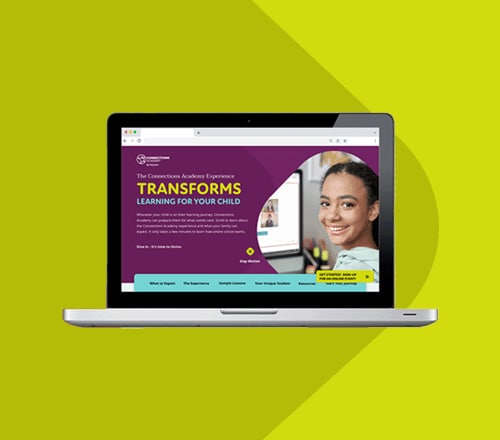Preparing Students for Skills-Based Hiring
byConnections Academy
4 min to read
Parents know what their children need; what excites them, challenges them, and what they dream of when they imagine their future. Every parent wants their child to find success and thrive—especially when it comes to preparing to enter the workforce.
In today’s job market, many employers are moving away from hiring practices that rely on a candidate’s degree. Instead, many recruiters are using skills-based hiring to find talent. With a reported 90% of companies hiring based on a candidate’s skills, families can help their students prepare for their futures by encouraging them to learn transferable skills while still in high school.
What is Skills-Based Hiring?
Skills-based hiring is the practice of evaluating a candidate’s skills and abilities to excel in a job regardless of their specific degree. Employers have shifted away from traditional hiring practices that relied heavily on choosing candidates who only held a specific—often four-year—degree in favor of finding candidates that have the required experience but perhaps certifications in another field or who have no completed a degree program.
The main idea behind skills-based hiring is to more easily find a job candidate that had valuable job skills and experience that will best suit the role rather than someone who happens to have a relevant degree.
For example, with skills-based hiring a software company may consider a software engineer with an impressive portfolio of past projects who only holds a certification in project management with as much consideration as an equally skilled software engineer who has a computer science degree. Despite one candidate having a degree in the field, both candidates are considered equally because their skills alone showcase their ability to do the job.
Why are Employers Focusing on Employee Competencies?
There are a lot of ways employers benefit from making the switch to skills-based hiring.
For example, let’s say a marketing agency is looking for a graphic designer. Rather than only considering candidates who have degrees related to graphic design, skills-based hiring would open recruiters up to applicants who have unrelated degrees or no degree at all. By focusing on skills instead of degrees, the agency can focus on finding not only a talented designer, but also one who has experience developing soft skills like working well with frequent feedback and time-management.
Skills-based hiring also allows employers to:
Close Technical Skills Gaps
It’s easier to hire for a technical job based on underlying skillsets and then provide training on industry specifics than it is to find a candidate who may have industry-specific experience.

Have Access to a Bigger Applicant Pool
Removing college degree requirements often creates a bump in the number of applicants that can pass resume screenings. With access to more applications, recruiters can review qualified candidates with a broad range of backgrounds and experiences who might have been excluded due to not having a specific degree.
What Skills-Based Hiring Means for Students Today
That’s not to say that the benefits of this kind of hiring are stacked only in the employers’ favor. Students are set up for success with this model in a few major ways:
- Transferable skills have a long shelf life: Because skills-based hiring relies on transferable skills, they can grow with them in their chosen careers and throughout life.
- It provides flexibility for career options: They can enjoy a breadth of employment opportunities based on the skills they have without being “locked in” to any one thing or having to go back to school to earn a formal degree.
- It values interpersonal skills: The underpinnings of skills-based hiring include professional skills like collaboration, time management, leadership, adaptability, critical thinking, and communication alongside any technically specific training required for the job.

How Can Parents Start Preparing Students for Skills-Based Hiring?
To help students prepare for this hiring model, it’s important to consider what careers they want to pursue after high school and how to help them take the first step. Here are some tips to get started:
1. Help Students Explore Their Interests
Guide your high school student in developing a career exploration plan that supports their interests and deepens their skills. Karen Muston, a certified school counselor at Connections Academy, said it’s “important to use the years in school to try new things, explore different interests, and participate in activities that give them some career readiness. The career exploration experiences students have in school could potentially lead to a fulfilling career that brings them joy, success, and, most importantly, well-being throughout their adult lives.”
2. Introduce Students to all Their Options
Having alternatives to formal degrees, like technical schools, presented to them helps students know that they have access to a promising and profitable future that’s rooted in sought-after professional traits, whether they choose to go to college or not. Whether they attend trade school online or learn hands-on through apprenticeships, summer jobs or internships, or through Connections Academy partnerships, students have the opportunity to capitalize on skills development all while building toward their future career goals.
3. Connect Students to Education that Supports Their Goals
More than ever, families should leverage the educational opportunities available for their children, especially through online resources like Connections Academy’s academic partnerships. Online upskilling platforms like Coursera can let kids earn professional certificates in areas like data analytics and social media marketing from companies like Meta and Google. Credly can help kids become digitally savvy earn micro credentials in essential skills like teamwork, professionalism, leadership, and communication. Working on these skills while they’re in high school can not only build their resume but will be a valuable part of preparing them for the future.
Explore Our Career Readiness Pathways
Connections Academy’s goal is to help prepare students for whatever comes next in life. Explore how our Career Readiness coursework prepares students for their future with focused classes in industries like business, healthcare, and information technology.



